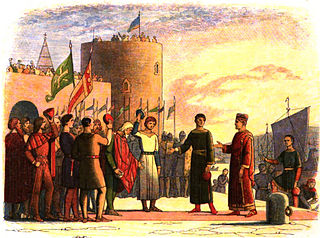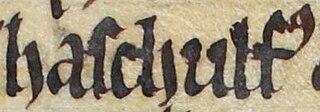| |||||
| Centuries: | |||||
|---|---|---|---|---|---|
| Decades: | |||||
| See also: | Other events of 1171 List of years in Ireland | ||||
Events from the year 1171 in Ireland.
| |||||
| Centuries: | |||||
|---|---|---|---|---|---|
| Decades: | |||||
| See also: | Other events of 1171 List of years in Ireland | ||||
Events from the year 1171 in Ireland.

Year 1171 (MCLXXI) was a common year starting on Friday of the Julian calendar.
Diarmait Mac Murchada, anglicised as Dermot MacMurrough, Dermod MacMurrough, or Dermot MacMorrogh, was a King of Leinster in Ireland. In 1167, he was deposed by the High King of Ireland, Ruaidrí Ua Conchobair. The grounds for the deposition were that Mac Murchada had, in 1152, abducted Derbforgaill, the wife of the king of Breifne, Tiernan O'Rourke. To recover his kingdom, Mac Murchada solicited help from King Henry II of England. His issue unresolved, he gained the military support of the Earl of Pembroke. At that time, Strongbow was in opposition to Henry II due to his support for Stephen, King of England against Henry's mother in the Anarchy. In exchange for his aid, Strongbow was promised in marriage to Mac Murchada's daughter Aoife with the right to succeed to the Kingship of Leinster. Henry II then mounted a larger second invasion in 1171 to ensure his control over Strongbow, resulting in the Norman Lordship of Ireland. Mac Murchada was later known as Diarmait na nGall. He was seen in Irish history as the king that invited the first-ever wave of English settlers, who were planted by the Norman conquest. The invasion had a great deal of impact on Irish Christianity, increasing the de facto ability of the Holy See to regulate Christianity in Ireland.
Richard de Clare, 2nd Earl of Pembroke, Lord of Leinster, Justiciar of Ireland, also known as Richard FitzGilbert, was an Anglo-Norman nobleman notable for his leading role in the Anglo-Norman invasion of Ireland. Like his father, Richard fitz Gilbert has since become commonly known by his nickname Strongbow, which may be a mistranscription or mistranslation of "Striguil".
Diarmait mac Máel na mBó was King of Leinster, as well as High King of Ireland. He was one of the most important and significant kings in Ireland in the pre-Norman era..
Toirdhealbhach Ua Briain, anglicised Turlough O'Brien, was King of Munster and effectively High King of Ireland. A grandson of Brian Bóruma, Toirdelbach was the son of Tadc mac Briain who was killed in 1023 by his half-brother Donnchad mac Briain.
Robert FitzStephen was a Cambro-Norman soldier, one of the leaders of the Norman invasion of Ireland, for which he was granted extensive lands in Ireland. He was a son of the famous Nest, daughter of Rhys ap Tewdwr, the last king of Deheubarth. His father was Nest's second husband, Stephen, Constable of Cardigan. Following the death of her first husband, Gerald de Windsor, her sons had married her to Stephen, her husband's constable for Cardigan. By Stephen, she had another son, possibly two; the eldest was Robert, and the younger may have been Hywel.
Tighearnán Mór Ua Ruairc, anglicised as Tiernan O'Rourke ruled the kingdom of Breifne as the 19th king in its Ua Ruairc dynasty, a branch of the Uí Briúin. He was a descendant of Uí Riagain, and one of the provincial kings in Ireland in the twelfth century, constantly expanding his kingdom through shifting alliances, of which the most long-standing was with Toirdelbach Ua Conchobair King of Connacht and High King of Ireland, and subsequently his son and successor Ruaidhrí Ua Conchobair. He is known for his role in the expulsion of Diarmait Mac Murchada, King of Leinster, from Ireland in 1166. Mac Murchada's subsequent recruitment of Marcher Lords to assist him in the recovery of his Kingdom of Leinster ultimately led to the Norman invasion of Ireland.

The Anglo-Norman invasion of Ireland took place during the late 12th century, when Anglo-Normans gradually conquered and acquired large swathes of land from the Irish, which the kings of England then claimed sovereignty over, as sanctioned by the Papal bull Laudabiliter. At the time, Gaelic Ireland was made up of several kingdoms, with a High King claiming lordship over most of the other kings. The Norman invasion was a watershed in Ireland's history, marking the beginning of more than 800 years of direct English and, later, British involvement in Ireland.

Aoife MacMurrough, also known by later historians as Eva of Leinster, was an Irish noblewoman, Princess of Leinster and Countess of Pembroke. She was the daughter of Dermot MacMurrough, King of Leinster, and his second wife, Mór Ní Tuathail or Mor O'Toole, and a niece of Archbishop of Dublin St Lawrence O'Toole.
Events from the year 1169 in Ireland.
Events from the year 1170 in Ireland.

Ascall mac Ragnaill meic Torcaill, also known as Ascall Mac Torcaill, was the last Norse-Gaelic king of Dublin. He was a member of the Meic Torcaill, a Dublin family of significance since the early twelfth century.

Donnchadh mac Briain, son of Brian Bóruma and Gormflaith ingen Murchada, was King of Munster.
Events from the 11th century in Ireland.
Mór Ní Thuathail was a Queen-consort of Leinster as the principal first wife of King Diarmait Mac Murchada. Under Brehon Law, Irish men were allowed more than one wife. King Dermot's second wife was Sadhbh Ní Fhaolain.

Affreca de Courcy or Affrica Guðrøðardóttir was a late 12th-/early 13th century noblewoman. She was the daughter of Godred Olafsson, King of the Isles, a member of the Crovan dynasty. In the late 12th century she married John de Courcy. Affrica is noted for religious patronage in northern Ireland.
Domhnall Caomhánach is the ancestor of the Caomhánach line of the Uí Ceinnselaig dynasty and was King of Leinster from 1171 to 1175. Domhnall was the eldest son of the 12th century King of Leinster, Diarmait Mac Murchada in Ireland.
Donnchad mac Domnaill Remair, also known as Donnchadh mac Domhnall Reamhair, was a late-eleventh-century ruler of the kingdoms of Leinster and Dublin. He was a son of Domnall Remar mac Máel na mBó. Donnchad was slain in 1089.
Énna Mac Murchada, or Enna Mac Murchada, also known as Énna mac Donnchada, and Énna mac Donnchada mic Murchada, was a twelfth-century ruler of Uí Chennselaig, Leinster, and Dublin. Énna was a member of the Meic Murchada, a branch of the Uí Chennselaig dynasty that came to power in Leinster in the person of his paternal great-grandfather. Énna himself gained power following the death of his cousin Diarmait mac Énna. Throughout much of his reign, Énna acknowledged the overlordship of Toirdelbach Ua Conchobair, King of Connacht, although he participated in a failed revolt against the latter in 1124 before making amends. When Énna died in 1126, Toirdelbach successfully took advantage of the resulting power vacuum.
Domnall mac Murchada, also known as Domnall mac Murchada meic Diarmata, was a leading late eleventh-century claimant to the Kingdom of Leinster, and a King of Dublin. As a son of Murchad mac Diarmata, King of Dublin and the Isles, Domnall was a grandson of Diarmait mac Máel na mBó, King of Leinster, and thus a member of the Uí Chennselaig. Domnall was also the first of the Meic Murchada, a branch of the Uí Chennselaig named after his father.